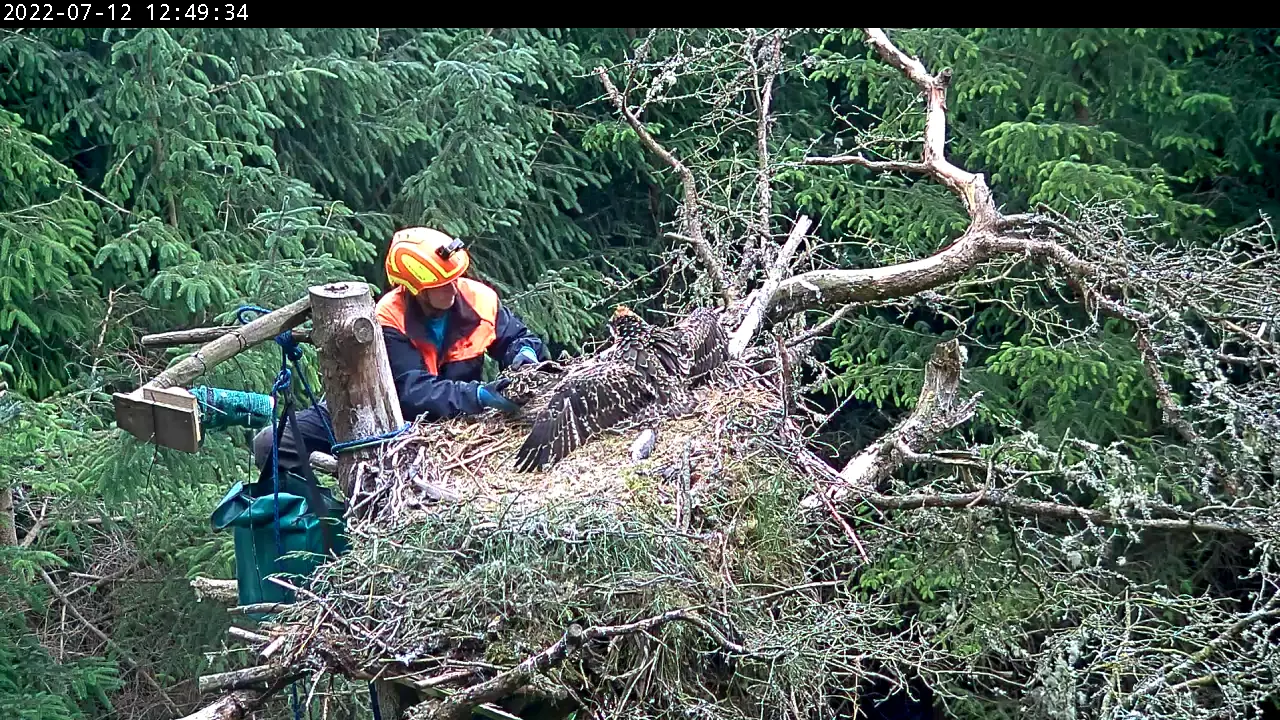Tagging the chicks
- Tweed Valley Osprey Project Co-ordinator, Di Bennett, brings us the latest update from the nest.
On 12 July the osprey juveniles in the main nest were 44 days old and were fitted with their identity rings and satellite tags. Tony Lightley, an Environment and Heritage Forester for Forestry and Land Scotland, and David Anderson, an environmental consultant, visited the site to carry out the work. Tony is licenced to ring the birds, and David to fit the satellite tracking tags.


Tony Lightley collecting the osprey juveniles for ringing and tagging
All of the osprey family were present at the nest when they arrived but the parents swiftly left upon their approach. The young ospreys lay flat in the nest in response to a perceived threat. Tony climbed the nest tree and carefully removed the young birds and lowered them to the ground for the ringing and tagging to be carried out.

Dave Anderson fitting the satellite tracker
Joining the team were a film crew from the exciting conservation initiative, Conservation Without Borders. They are taking part in the Flight of the Osprey expedition this autumn and will be using data from the trackers of these ospreys to help inform their research. This is what they had to say about the project:
"Flight of the Osprey is an innovative approach to conservation, highlighting grassroots projects along the flyway in collaboration with UN agencies, scientists, media and governments.
"Accompanying the osprey on its 2022 autumn migration across Europe and Africa, this 10,000 km expedition will gather vital data on the threats faced by this iconic bird of prey and other migratory species. At the same time, we will create a unique platform from which to engage, educate and empower communities along the flyway and further afield, promoting a deeper understanding of the challenges to migratory birds, both within and beyond the conservation community."
The basic biometrics of the juveniles were recorded which involved measuring their wing length and weight. Their general health and condition was assessed before they were fitted with a unique identification ring, and also a visible identification ring known as the Darvic ring. The three birds were all males and even though we have witnessed one chick set apart at feeding throughout the summer, there was not much difference in weight between him and his two brothers. All were deemed to be strong and healthy birds. The Darvic rings were blue with numerical digits 706, 707 and 708.


Chicks 706, 707 and 708 ready to go back to their nest
The satellite tracking devices fitted to the birds will relay data back to us from wherever the birds go to once they fledge from their nest, and we can follow their journey. We have had disappointing tracking results in the past when birds have stopped transmitting satellite data in Spain, Portugal and Morocco. Young ospreys on migration face an extremely hazardous time and the project Conservation Without Borders will hopefully be able to follow the flyways of ospreys and investigate to see these challenges first hand. This research may help in future to find solutions which is vital to prevent so many fatalities once ospreys leave on their migration journeys.
Video highlights
Keep an eye on our 2022 highlights YouTube playlist where we're uploading our favourite clips from the nest.